|
|
|
 |
|
NRCS Home
|
|
|
| |||||||||||||||||||||||||||||||
|
National Media Liaisons:
Terry Bish, 202-720-3210 Sylvia Rainford, 202-720-2536 State News and Public Affairs Contacts |
Some documents require Adobe Acrobat reader.
![]() indicates a USDA
News Release.
indicates a USDA
News Release.
 Iowa Soybean Association Wins Top Conservation Innovation Grant Poster Award
Iowa Soybean Association Wins Top Conservation Innovation Grant Poster AwardThe Iowa Soybean Association (ISA) took top NRCS honors for its Conservation
Innovation Grant poster presentation displayed at the Soil and Water
Conservation Society's Annual Conference in Tucson, Arizona.
ISA's large-scale, multiple-year study (awarded a CIG in 2006)
Implementing Adaptive Management of Nitrogen in Iowa Corn
Fields will help Iowa
corn growers adopt and improve nitrogen management. The study
(summarized
here)
looked at 35 groups of growers that used precision farming technologies, remote
sensing, guided corn stalk nitrate survey, and strip-trial methodology in more
than 1,000 fields across Iowa in 2007. Evaluations reveal great opportunities
for reducing growers' uncertainties about nitrogen management and encouraging
implementation of nitrogen management practices.
ISA's entry finished in front of 30 competitors from across the U.S.
Winrock International's presentation Pilot-Testing
Performance-Based Incentives for Agricultural Pollution Control, won
second-place CIG honors with its look at how performance-based incentives can
improve the technical and cost effectiveness of
agricultural non-point source pollution control.
Washington State University rounded out the top three honorees with its project
-- a study of nutrient capture and redistribution in a community anaerobic
digester.
NRCS Chief Arlen Lancaster presented the awards.
CIG promotes development and adoption of innovative conservation approaches and
technologies, and brings NRCS into partnership with public and private entities
to speed the transfer and adoption of promising technologies that will address
some of the nation’s most important natural resource concerns.
Links...
Iowa Soybean Association
Conservation Innovation Grants
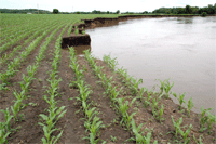 Recent flooding severely eroded this streambank in Dallas County, Iowa. EWP program funding can be used to protect eroded streambanks caused by flooding and other natural disasters ( NRCS image). |
WASHINGTON, July 25, 2008—Agriculture Secretary Ed Schafer announced $390
million is available through the Emergency Watershed Protection program for
landowners and communities to cope with the aftermath of recent floods, fires,
drought, tornadoes and other natural disasters. The $390 million is included in
a $162 billion supplemental bill that helps Midwest sates with areas ravaged by
recent flooding. It also provides funding to cover about $140 million in EWP
projects from earlier natural disasters such as tornadoes and wildfires. Public
and private landowners are eligible for assistance through the EWP program, but
they must be represented by a sponsor. Sponsors include any legal subdivision of
state or local government.
Links…
![]() USDA
news release “Schafer Announces $390 Million Available for Natural Disaster
Recovery Assistance” (July 25, 2008)
USDA
news release “Schafer Announces $390 Million Available for Natural Disaster
Recovery Assistance” (July 25, 2008)
Emergency Watershed Protection
Program
EWP Questions and
Answers
|
"Soils are the foundation of life." Agriculture Secretary Ed Schafer addresses the importance of healthy and productive soils at a preview of "Dig It! The Secrets of Soils," a new exhibition at the National Museum of Natural History. USDA image. |
WASHINGTON,
July 17, 2008—Agriculture
Secretary Ed Schafer announced that USDA has loaned 54 designated state and
territory soil samples to the Smithsonian Institution for a new soils exhibition
that opens July 19 at the National Museum of Natural History in Washington, DC.
“This exhibition reminds our nation about the importance and benefits of healthy
and productive soils,” Schafer said. “Soils are a vital resource; they are the
foundation of life. We should protect them and do what we can to increase public
awareness about their significance.”
The soil samples—or monoliths—are part of a gallery of monoliths representing
all the states, the District of Columbia, the Caribbean and the Pacific Islands.
An extensive map created by USDA’s Natural Resources Conservation Service offers
visitors the “big picture” by allowing them to learn more about soils around the
world.
|
A sample of the samples. This lineup of several state soil monoliths reveal just some the "Secrets of the Soil" on display at at the National Museum of Natural History. USDA image. |
The 5,000-square foot exhibition, called “Dig It! The Secrets of Soil,” also
includes interactive displays, hands-on models and videos. The exhibition will
be featured at the natural history museum for nearly two years. Following its
showing at the natural history museum, “Dig It!” is expected to travel to 10
museums across the country through 2013 under the auspices of the Smithsonian
Institution Traveling Exhibition Service.
At an event at USDA headquarters, USDA honored 70 federal employees,
mostly from USDA, Department of Interior and the Smithsonian Institution who
assisted with the exhibition’s development.
Links…
![]() News Release
USDA Has Loaned
Designated Soil for Each State and Territory to Smithsonian Institution for "Dig
It!" Exhibition
News Release
USDA Has Loaned
Designated Soil for Each State and Territory to Smithsonian Institution for "Dig
It!" Exhibition
NRCS State Soils
Additional information about "Dig It! The Secrets of Soil" can be found at http://forces.si.edu/soils. Information about USDA-NRCS's Soil Survey Program nationwide can be found at http://soils.usda.gov. Information about the "Dig It! tour can be found at http://www.sites.si.edu.
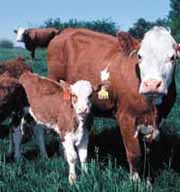 WASHINGTON, July 15, 2008—Agriculture
Secretary Ed Schafer announced an additional $200 million will be made available
through the 2008 Farm Bill to help farmers and ranchers nationwide solve natural
resource problems through the Environmental Quality Incentives Program. An
additional $2.5 million will be available for Agricultural Management Assistance
in 16 states. USDA’s Natural Resources Conservation Service administers EQIP and
AMA, which provide financial and technical assistance to producers. Congress
provided the extra funds for both programs for fiscal year 2008 when it
reauthorized them in the 2008 Farm Bill. Congress added Hawaii to AMA when that
program was reauthorized.
WASHINGTON, July 15, 2008—Agriculture
Secretary Ed Schafer announced an additional $200 million will be made available
through the 2008 Farm Bill to help farmers and ranchers nationwide solve natural
resource problems through the Environmental Quality Incentives Program. An
additional $2.5 million will be available for Agricultural Management Assistance
in 16 states. USDA’s Natural Resources Conservation Service administers EQIP and
AMA, which provide financial and technical assistance to producers. Congress
provided the extra funds for both programs for fiscal year 2008 when it
reauthorized them in the 2008 Farm Bill. Congress added Hawaii to AMA when that
program was reauthorized.
Links…
![]() News Release
Schafer Announces An Additional $202.5 Million For Two Voluntary Programs
News Release
Schafer Announces An Additional $202.5 Million For Two Voluntary Programs
Environmental Quality
Incentives Program
Agricultural Management
Assistance

On
Monday, July 14, USDA's Natural Resources Conservation Service will hold a
public listening session on the Chesapeake Bay provisions of the 2008 Farm Bill.
Stakeholders and the public are encouraged to bring their ideas about practices,
programs, and geographic areas they see as priorities under these provisions.
The session begins at 10:00 a.m. in the Lowes Annapolis Hotel, Ballrooms A&B.
The hotel's address is 126 West Street, Annapolis, Maryland, 21401. Telephone:
(410) 263-7777.
Where to Send Written Comments
Written comments can be sent via Fed-Ex or regular mail to the
following address:
Dan Lawson, Branch Chief
Conservation and Watershed Planning, Room 6008
USDA-NRCS
1400 Independence Ave., S.W.
Washington, D.C. 20250-1600
Telephone: 202-720-5322
Dan can be e-mailed at the following address:
Dan.Lawson@wdc.usda.gov
Links...
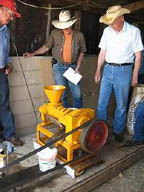 Encouraging cutting-edge conservation. Past CIG grantee Oilseeds for the Future creates opportunities for Montana farmers who want to participate in, and benefit from, an emerging bio-based economy. This project encourages the production and use of oilseeds that can be used for lubricants, culinary oils, and biodiesel. Above, project participants examine an oilseed crusher. National Center for Appropriate Technology image. |
WASHINGTON, June 23,
2008—Agriculture Secretary Ed Schafer today announced $14 million in
Conservation Innovation Grants (CIG) to fund 45 projects in 40 states to develop
and refine cutting-edge technologies and approaches that will help farmers
conserve and sustain natural resources on their operations.
CIG, administered by the Natural Resources Conservation Service (NRCS), targets innovative, on-the-ground conservation, including pilot projects and
field demonstrations. Grants go to state and local governments, tribes,
non-governmental organizations and individuals.
Approved CIG projects address traditional natural resource issues such as
water quantity, water quality improvement, livestock nutrient management,
grazing lands and forest health, and soil resource management. The projects also
address emerging natural resource issues, including agricultural air emissions,
energy conservation and market-based approaches to conservation.
On June 10, USDA announced $5 million in Conservation Innovation Grants to fund
11 innovative projects in 6 states to protect water quality, recycle nutrients
and improve wildlife habitat in the Chesapeake Bay watershed.
CIG is part of NRCS' Environmental Quality Incentives Program. NRCS provides
technical oversight for each project. Grantees provide technical assistance
required to successfully complete their projects.
CIG funding is awarded through a nationwide competitive grants process.
Links...
![]() News Release
USDA Awards $14
Million in Conservation Innovation Grants
News Release
USDA Awards $14
Million in Conservation Innovation Grants
NRCS News Release
USDA-NRCS
Provides $5 Million in Conservation Innovation Grants to Protect Water Quality
in the Chesapeake Bay Watershed
List of Grantees:
Conservation Innovation Grants
Awards Fiscal Year 2008
Conservation Innovation Grants
 Cleaning up the water before it flows to the bay. Contour strips on this bay-area farm trap soil, nutrients and pesticides before they enter valuable waterways that refresh the Chesapeake Bay. Conservation Innovation Grants foster new technologies and approaches that build on and compliment traditional conservation methods such as this. Chesapeake Bay Foundation image. |
WASHINGTON, June 10, 2008—U.S. Department of Agriculture’s Natural Resources
Conservation Service Chief Arlen Lancaster announced that $5 million will be
used to fund 11 innovative projects in 6 states to protect water quality,
recycle nutrients and improve wildlife habitat in the Chesapeake Bay watershed
through Conservation Innovation Grants in fiscal year 2008.
“These grants will foster innovative technologies and approaches to conservation
that will assist local efforts to improve the natural resources of the
Chesapeake Bay watershed through cooperative conservation and collective
action,” Lancaster said. Projects in the Chesapeake Bay watershed will
also address emerging natural resource issues including energy conservation and
market-based approaches to conservation.
Links...
NRCS News Release
USDA-NRCS
Provides $5 Million in Conservation Innovation Grants to Protect Water Quality
in the Chesapeake Bay Watershed
Conservation Innovation Grants
 Regional Assistant Chief Richard Coombe. Coombe brought his expertise in watershed protection and planning to discussions at the Global Katoomba Conference held June 9-10 in Washington, DC. USDA image. |
WASHINGTON, June 10, 2008—Regional Assistant Chief for the East Richard Coombe
served as a panelist at the Global Katoomba Conference, an international
conference on market-based conservation, held at the Smithsonian Institution’s
National Museum of Natural History, June 9-10.
Coombe shared his expertise
as a member of the team that worked to revitalize the New York City Watershed
several years ago. As the Founding Chair and CEO of the Watershed Agricultural
Council, Inc., from 1993 – 2003, Coombe was instrumental in implementing a
comprehensive planning approach to watershed protection in the 1.2 million acre
New York City Watershed, a vital water source for over 9 million residents.
This
year’s Global Katoomba Conference focused on the current scope and potential of
ecosystem markets – carbon, water and bio-diversity – to address environmental
concerns.
Links…
NRCS News Release
USDA
Official Provides Expertise at International Conference
Regional Assistant Chief
Richard Coombe's biography
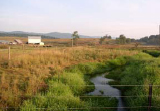 Practices like conservation buffers along streams improve and protect water quality throughout the Chesapeake Bay watershed. The watershed covers nearly 45 million acres in 6 states and the District of Columbia. |
WASHINGTON, June 4, 2008—U.S. Department of Agriculture’s Natural Resources
Conservation Service recently released a report highlighting its activities in
the Chesapeake Bay watershed for fiscal year 2007.
For example, NRCS provided
more than $76 million in financial and technical assistance in the Chesapeake
Bay watershed to help farmers protect water quality, recycle nutrients, preserve
open spaces and improve wildlife habitat. The agency used existing Farm Bill
programs such as Environmental Quality Incentives Program, Wildlife Habitat
Incentives Program, Farm and Ranch Lands Protection Program and Wetlands Reserve
Program to help farmers carry out conservation practices such as riparian
buffers, prescribed grazing systems, irrigation water management, nutrient
management systems, waste storage and manure composting facilities and wetland
creation, restoration and enhancement.
Links…
Conserving Natural Resources in the Chesapeake Bay: NRCS 2007 Conservation Activities (PDF; 535KB)
Chesapeake Bay
Conservation
 Rewarding high standards in conservation. CSP offers payments for enhancing natural resources, rewards model conservation-ists, and provides incentives for other producers. |
WASHINGTON, May 7, 2008—NRCS Chief Arlen Lancaster announced that producers
in 51 eligible watersheds nationwide will have two additional weeks to apply for
the Conservation Security Program in fiscal year 2008. The sign-up began April
18, 2008 and now ends May 30, 2008. Originally, the sign-up was scheduled to end
on May 16, 2008. NRCS is extending the sign-up to give farmers and ranchers as
much time as possible to gather their natural resource information and complete
the required self-assessment and applicant interview. Also, natural
disasters—such as excessive spring rains and flooding in certain parts of the
country that caused delays in planting—played a role in the agency’s decision,
Lancaster said. A notice of the extension is scheduled to be published in the
Federal Register on Friday, May 9, 2008.
Links…
NRCS News Release USDA
Extends Sign-up for 2008 Conservation Security Program
Conservation Security
Program Watersheds for Fiscal Year 2008
Federal Register
Notice of CSP Signup Extension
Conservation Security Program
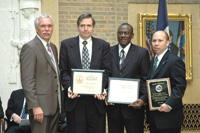 Special Recognition. Secretary Ed Schafer presents a Special Recognition Award to NRCS Chief Arlen Lancaster and Certificates of Appreciation to Herby Bloodworth and Melvin Westbrook for work done by NRCS employees in Afghanistan and Iraq. |
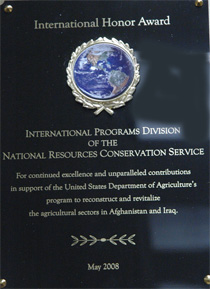 Inscription: International Programs Division, NRCS. For continued excellence and unparalleled contributions in support of the USDA's program to reconstruct and revitalize the agricultural sectors in Afghanistan and Iraq. |
On Friday, May 2, USDA honored more than 40 Department employees, including 14
NRCS personnel, for their service in Afghanistan and Iraq. The ceremony
recognized those who have completed deployments as Provincial Reconstruction
Team (PRT) agriculture advisors, ministry advisors, or Foreign Service officers
serving at the U.S. Embassy in Baghdad.
“The greatest honor we can bestow on the USDA employees here with us today is to
continue the mission to help rebuild and revitalize the physical and
institutional agricultural sectors in Afghanistan and Iraq so that the work they
performed will have lasting effects for the people and land of those countries,”
said Secretary Ed Schafer.
Secretary Schafer presented a special recognition award to Natural Resources
Conservation Service Chief Arlen Lancaster for having contributed more employees
than any other USDA agency to the U.S. Government effort to stabilize and
rebuild both countries. They are:
| Afghanistan and Iraq | Afghanistan | Iraq |
| Manuel Ayala |
Alan Wood |
Rebecca Burt |
Secretary Schafer and Under Secretary Mark Rey presented an award to the family
of Steven Thomas “Tom” Stefani, a Forest Service employee, who died while
voluntarily serving as an agricultural advisor on a PRT in Afghanistan.
Secretary Schafer presented the Thomas Jefferson Star award, along with Under
Secretary Patrick Kennedy from State Department, to the Stefani family.
Link...
![]() Schafer Recognizes Work of USDA Provincial Reconstruction Team Advisors Who
Served in Afghanistan and Iraq
Schafer Recognizes Work of USDA Provincial Reconstruction Team Advisors Who
Served in Afghanistan and Iraq
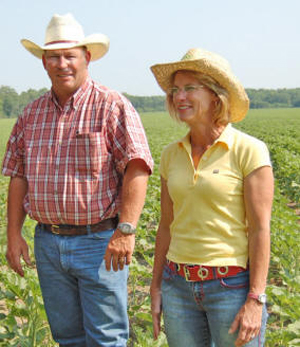 Winners of the 2008 Excellence in Conservation Award. Mike and Annie Dee of Dee River Ranch go the extra mile to ensure their operation is profitable and environmentally sound, while reducing erosion and improving soil and habitat. NRCS Alabama image. |
On April 30, 2008, Deputy Under Secretary for Natural Resources and
Environment Gary Mast presented the 2008 Excellence in Conservation Award to
Mike and Annie Dee of Dee River Ranch, Aliceville, Alabama.
“True conservation of our natural resources can be achieved only when groups and
individuals put their commitment to conservation into action,” said Mast. “Annie
and Mike Dee share their knowledge of conservation with communities and
individuals across Alabama regularly and with distinction.”
Mike and Annie are very stewardship conscious. Mike says, "As we think of
stewardship, we can’t be limited to look at next year’s crops, be it corn,
wheat, or cattle. We have to think about the next 10 years. We have to be
improving the soil and the environment all the time because we have to produce
more from every acre to maintain our livelihood and success. We have to be
improving all the time, not just maintaining."
Brother and sister Mike and Annie Dee have gone the extra mile to ensure that
their farming operation is not only profitable but also environmentally sound.
They have incorporated conservation practices into their farming operation that
have enhanced the productivity of the farm, reduced soil erosion, improved
moisture retention in the soil, and provided wildlife habitat.
The award ceremony was held at the Renaissance Montgomery Hotel and Convention
Center during the national observance of Soil and Water Stewardship Week, April
27 to May 4, 2008. Alabama Commissioner of Agriculture and Industries, Ron
Sparks, and NRCS Assistant State Conservationist, Zona Beaty, joined Deputy
Under Secretary Mast in recognizing the leadership, accomplishments and
cooperative efforts of Dee River Ranch.
The NRCS Excellence in Conservation Award as a national award is the highest
award the agency gives to honor those outside the Federal government for their
work in conservation. This annual award recognizes the voluntary contributions
of non-governmental individuals, groups, and Tribes through their conservation
efforts in areas of technical assistance, programs delivery, technology
transfer, outreach, or communication.
Link...
NRCS News Release
USDA Honors Dee River Ranch for Conservation Work
NRCS Alabama Feature Article
Miles of Stewardship: The Dee River Ranch
Dee River
Ranch: True Excellence in Conservation
(Remarks prepared for delivery by Gary W. Mast, USDA Deputy Under Secretary for
Natural Resources and the Environment, for the NRCS 2008 Excellence in
Conservation Award Ceremony)
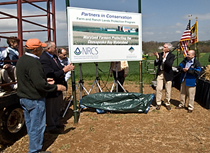 Partners preserve Maryland farmland. Secretary Schafer and NRCS Chief Arlen Lancaster (at right), landowner Glenn Elseroad (in orange cap at left), and State and local officials applaud the announcement of funding to protect hundreds of acres of Maryland farmland from development. USDA image. |
On Earth Day 2008, Agriculture Secretary Ed Schafer announced that Maryland will receive $2.6
million in Fiscal Year 2008 to protect agricultural land through the Natural
Resources Conservation Service's Farm and Ranch Lands Protection Program (FRPP).
Funding will be distributed to the Baltimore County Agricultural Land
Preservation Program and the Eastern Shore Land Conservancy.
The two agreements will protect 622 acres of farmland. Baltimore County's $1.6
million will protect 341 acres on five farms. The Eastern Shore Land Conservancy
agreement covers 281 acres on a family farm in Talbot County, the second phase
of this agricultural land preservation project.
Secretary Schafer announced the funding at an Earth Day celebration held on the
Glenn Elseroad Farm in Reisterstown, Maryland.
USDA-NRCS in Maryland has worked with 15 cooperating entities to protect about
35,000 acres on 257 farms through FRPP since its inception. Maryland has used
more than $31 million in FRPP funds since 1996.
FRPP has protected about 533,000 acres on 2,764 farms and ranches nationwide
from 1996-2007. In that time, USDA-NRCS has invested $536 million into FRPP
across the country, working with 348 cooperating entities.
Links...
![]() USDA Provides $2.6 Million to Protect Farmland in Maryland
USDA Provides $2.6 Million to Protect Farmland in Maryland
Farm and Ranch Lands
Protection Program
EarthDay.gov
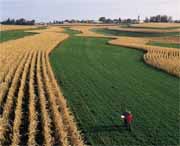 NRCS' 2008 Conservation Security Program signup to help more farmers and ranchers put more conservation on the land. CSP rewards and encourages the use of conservation practices, such as stripcropping, to protect and sustain natural resources. NRCS image. |
Agriculture Secretary Ed Schafer announced a sign-up for the Conservation
Security Program will be available starting on April 18 to approximately 64,000
potentially eligible farms and ranches in 51 watersheds covering more than 23.7
million acres.
"Since the first sign-up in 2004, CSP has offered payments for enhancing natural
resources, rewarding those farmers and ranchers who are model conservationists,
and providing incentives for other producers to achieve those same high
standards of conservation in agriculture," Schafer said.
This announcement, open from April 18 to May 16, brings the number of watersheds enrolled to 331
across the Nation, covering 247.7 million acres that have been eligible for the
program.
CSP is a voluntary program that supports ongoing stewardship of private,
agricultural working lands and rewards those producers who are meeting the
highest standards of conservation and environmental management on their
operations.
The sign-up announcement and specific program requirements are being published
in the Federal Register.
Links...
![]() Schafer Announces Conservation Security Program Sign-Up
Schafer Announces Conservation Security Program Sign-Up
2008 Conservation Security Program Watersheds
Conservation Security Program
USDA Radio News clips featuring
Chief Lancaster on the Conservation Security Program (mp3 files)
Conservation Security Program sign-up soon underway (MP3; 930K)
New
CSP sign-up under current farm bill rules (MP3; 919K)
Pilot Environmental tools part of latest CSP sign-up (MP3; 945K)
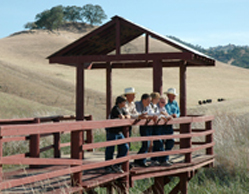 Environmental Stewardship Award winners, the Stone Family of Yolo County, California. Known nationwide as big-picture conservationists, the Stones improve every resource on their 7,500-acre operation, enhancing the resource base and providing social benefits across two watersheds. |
The Stone Family of Yolo County, California, is the national winner of the
Environmental Stewardship Award Program. The Stones preserve the natural beauty
and wildlife of their ranch, practice innovative resource management, while
raising one of the top commercial herds of Angus cattle in California.
“This year the selection of a national winner was extremely difficult, with six
strong applications vying for the national award,” explains Iowa cattleman Dave
Petty, chairman of the selection committee. “All of these stewards are operating
in difficult environmental conditions and they are going above and beyond. It
gives us great pleasure to award the Stone Family, who has been operating for
generations, as this year’s national winner. Their commitment to the cattle
industry and preserving their land, speaks volumes about the operations
commitment to conservation.”
"Many people who come to us for conservation help come seeking answers and fixes
for one problem—erosion or invasive species, water issues or whatever it may
be," says Phil Hogan, Yolo County District Conservationist for USDA's Natural
Resources Conservation Service (NRCS). "But the Stones have tackled and achieved
improvements in each resource: soil, water, native plants, and wildlife habitat.
They are big picture people."
Hank and Suzanne Stone, owners of Yolo Land & Cattle Company, along with their
sons, Scott and Casey Stone, and their wives, Karen and Angela Stone, have made
it a family goal to continually enhance and improve their ranching operation
while involving the community. Their efforts have brought together their
neighbors, surrounding school children, Audubon California and California
Department of Forestry and Fire Protection, NRCS and other state and local
organizations and agencies. Their vegetative management program has become
California’s largest for the purpose of conducting annual spring grass burns and
fall brush burns on a total of 45,000 acres in western Yolo County.
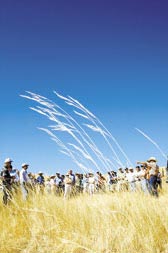 Attracting conservationists by the busload. Conservation activities put into practice on the Stone Family's Yolo County ranch attract conservationists, public officials, students, and many others from around the country. This visit brought in current and past USDA officials to see how Federal programs benefit the Stone's operation and the local resource base. |
The long list of improvements that the Stone's have made in their 7,500 acre
ranch includes replacing annual and invasive species with native grass plantings
and prescribed burning, rotationally grazing their herd and excluding them from
ponds and streams with the assistance of fencing and solar-powered watering
troughs; restoration of ponds through grading, fencing and planting native
grasses, shrubs and trees.
According to Hogan the mere size of the Stone ranch, strategically located
against the Central Coast Range and spreading across two watersheds gives them a
special opportunity to improve social benefits such as water quality and
wildlife corridors which are much harder to achieve with smaller parcels of
land.
The Stones, however, have enlarged these benefits beyond their own considerable
holdings by involving neighbors, partners, and the public in their efforts. For
example, Scott Stone, worked with Audubon California to convince 26 neighbors to
take part in an effort with California Department of Forestry and Fire
Protection (CALFIRE) to control brush encroachment into the grasslands and
improve habitat qualities of the land. It is the largest Vegetation Management
Plan of its kind in the State.
Public education opportunities on the ranch have involved everyone from budding
NRCS conservationists to school children to chefs from the Culinary Institute of
America.
"People across America essentially desire the same things: open spaces, clean
water and a safe food supply, produced in an environmentally healthy and
sustainable manner. That is how we try to run our businesses," says Scott Stone.
NRCS, the National Cattlemen’s Foundation, the National Cattlemen's Beef
Association, Dow AgroSciences, and the U.S. Fish & Wildlife Service sponsor the
award program.
Links...
Landowner Profile : Hank Stone (PDF; 268KB)
Stone Ranch
Photo Gallery
NRCS California news release
Yolo Land & Cattle Company Wins National Environmental Stewardship Award
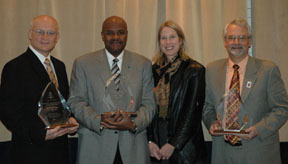 The American Forest Foundation honors three NRCS State Conservationists. From left to right, Richard Sims, State Conservationist of Idaho, Terry Cosby, State Conservationist of Ohio, AFF Senior Vice President Kathy McGlauflin, and Illinois State Conservationist Bill Gradle. NRCS image. |
On February 14, NRCS leaders from across the Nation
honored outstanding employees and volunteers who go the extra mile to help people help the land.
These individuals and organizations exemplify the spirit that fires the Agency's
just-released Conservation... Our
Purpose. Our Passion. campaign, and play pivotal roles in helping
private landowners and inspire others to put conservation on the ground—the true measure of our
success as an Agency and a conservation community.
Links to the winners...
The American Forest
Association's NRCS State Conservationist Awards honoring three innovative
NRCS State Conservationists committed to improving forest resources and building
and strengthening partnerships.
National Civil Rights Awards celebrating
outstanding outreach, and employee recruitment and retention.
Earth Team Awards spotlights volunteers
who
turn their time and talent to putting conservation on the land.
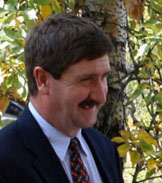 Third-generation Montana farmer Milo “Buzz” Mattelin, winner of the 1st Annual NACD/NRCS Olin Sims Conservation Leadership Award. |
Montana farmer Milo L. “Buzz” Mattelin has received the 1st Annual NACD/NRCS
Olin Sims Conservation Leadership Award for his leadership and service in
conserving natural resources on privately owned land.
Mattelin, a third-generation Montana farmer, has helped establish working
relationships with federal, state, and local government agencies; tribes; and
private and nonprofit conservation organizations.
“Buzz Mattelin’s leadership has been instrumental in establishing conservation
partnerships at all levels. His efforts have produced real conservation benefits
on the land and inspired others to be better stewards,” said NRCS Chief Arlen
Lancaster.
Mattelin's family has had a presence along the Missouri River in Montana for
more than 93 years. He became involved in Missouri River issues in the early
1990s with a grassroots effort that has become the Lower Missouri Coordinated
Resource Management Council.
He is also a founding member of the Missouri River Conservation Districts
Council, comprised of the 16 conservation districts that border the Missouri
River in Montana.
He earned a Bachelor of Science Degree from Colorado State University 1975.
Established in tribute to the late NACD President, the Olin Sims Conservation
Leadership Award recognizes outstanding conservation leadership at the state and
local levels. Sims, a rancher from McFadden, Wyoming, lived a life distinguished
by years of volunteer service to conservation.
Link...
NRCS news release: Montana
Farmer Honored with 1st Annual NACD/NRCS Olin Sims Conservation Leadership Award
 Conservation…Our
Purpose. Our Passion.
Conservation…Our
Purpose. Our Passion.
On a daily basis, NRCS employees, landowners and partners work together in a
relationship of trust and cooperation that engenders success, leading to more
productive lands and a healthier environment for all Americans. When farmers and
ranchers talk about the work they’ve done on their land, they’re telling NRCS’
story, too. “Conservation…Our Purpose. Our Passion.” is designed to gain
recognition for all the ways cooperative conservation supports our national
priorities of cleaner air and water, improved soils and increased wildlife
habitat. To learn more, follow the links below.
Links...
Conservation...Our Purpose. Our Passion. feature page with the
campaign video and success stories that spotlight landowners from every state
who reached their conservation goals with the help of NRCS conservation
technical assistance and other programs.
NACD and NRCS - A Shared Passion for Conservation (A speech
delivered by NRCS Chief Arlen Lancaster to the National Association of
Conservation Districts' Annual Meeting, February 12, 2008)
|
|
Minnesota’s sub-zero temperatures
couldn’t put a freeze on National Pheasant Fest 2008, Pheasants Forever’s (PF)
25th Anniversary celebration held January 18-20 in St. Paul.
The record-breaking attendance mark of 29,802 made the event the largest in
organization’s history.
USDA Secretary Chuck Conner at a Pheasant Fest news conference announced
approval for 45 proposals of State Acres For wildlife Enhancement (SAFE)
projects covering nearly 260,000 acres in 18 States. SAFE proposals encourage
state-specific wildlife focused projects.
Natural Resources Conservation Service (NRCS) Chief Lancaster, in his
Saturday-evening keynote address, read a letter from President George W. Bush
recognizing PF’s 25 years.
“Your organization has worked successfully to protect and improve habitat
through education and responsible land management programs,” said President
Bush, “and this anniversary is a chance to celebrate your accomplishments and
continue your good work.”
Lancaster told PF members that they have very much to be proud of. “Instead of
just nodding your heads in agreement at the kitchen table, you and your
neighbors heeded the call and have remained steadfast for 25 years.”
NRCS, the Farm Service Agency, and the U.S. Fish and Wildlife Service recognized
PF with awards marking its 25 years of conservation success.
Since its inception in 1982, PF’s wildlife habitat projects have benefited more
than 4 million acres across North America. It has partnered in nearly 1,000
different land recovery projects, totaling well over 100,000 acres. Many of
these projects were completed in conjunction with Federal, State, and local
natural resource agencies.
Pheasants Forever assists USDA with conservation implementation through such
programs as the Wetlands Reserve Program, Wildlife Habitat Incentives Program,
Environmental Quality Incentives Program, Grassland Reserve Program, and the
Conservation Reserve Program.
Links...
![]() Conner Unveils First Wildlife Plans in New Conservation Practice
Conner Unveils First Wildlife Plans in New Conservation Practice
Pheasants
Forever: 25 Years of Leadership and Achievement (Remarks by NRCS Chief Arlen
Lancaster)
Pheasants Forever
< Current News Releases
< Archived Newsroom and News Releases
|
|